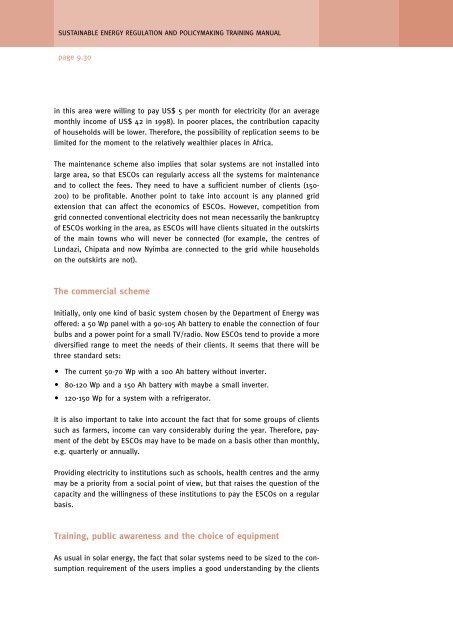Regulatory and policy options to encourage development of ...
Regulatory and policy options to encourage development of ...
Regulatory and policy options to encourage development of ...
- No tags were found...
Create successful ePaper yourself
Turn your PDF publications into a flip-book with our unique Google optimized e-Paper software.
SUSTAINABLE ENERGY REGULATION AND POLICYMAKING TRAINING MANUALpage 9.30in this area were willing <strong>to</strong> pay US$ 5 per month for electricity (for an averagemonthly income <strong>of</strong> US$ 42 in 1998). In poorer places, the contribution capacity<strong>of</strong> households will be lower. Therefore, the possibility <strong>of</strong> replication seems <strong>to</strong> belimited for the moment <strong>to</strong> the relatively wealthier places in Africa.The maintenance scheme also implies that solar systems are not installed in<strong>to</strong>large area, so that ESCOs can regularly access all the systems for maintenance<strong>and</strong> <strong>to</strong> collect the fees. They need <strong>to</strong> have a sufficient number <strong>of</strong> clients (150-200) <strong>to</strong> be pr<strong>of</strong>itable. Another point <strong>to</strong> take in<strong>to</strong> account is any planned gridextension that can affect the economics <strong>of</strong> ESCOs. However, competition fromgrid connected conventional electricity does not mean necessarily the bankruptcy<strong>of</strong> ESCOs working in the area, as ESCOs will have clients situated in the outskirts<strong>of</strong> the main <strong>to</strong>wns who will never be connected (for example, the centres <strong>of</strong>Lundazi, Chipata <strong>and</strong> now Nyimba are connected <strong>to</strong> the grid while householdson the outskirts are not).The commercial schemeInitially, only one kind <strong>of</strong> basic system chosen by the Department <strong>of</strong> Energy was<strong>of</strong>fered: a 50 Wp panel with a 90-105 Ah battery <strong>to</strong> enable the connection <strong>of</strong> fourbulbs <strong>and</strong> a power point for a small TV/radio. Now ESCOs tend <strong>to</strong> provide a morediversified range <strong>to</strong> meet the needs <strong>of</strong> their clients. It seems that there will bethree st<strong>and</strong>ard sets: The current 50-70 Wp with a 100 Ah battery without inverter. 80-120 Wp <strong>and</strong> a 150 Ah battery with maybe a small inverter. 120-150 Wp for a system with a refrigera<strong>to</strong>r.It is also important <strong>to</strong> take in<strong>to</strong> account the fact that for some groups <strong>of</strong> clientssuch as farmers, income can vary considerably during the year. Therefore, paymen<strong>to</strong>f the debt by ESCOs may have <strong>to</strong> be made on a basis other than monthly,e.g. quarterly or annually.Providing electricity <strong>to</strong> institutions such as schools, health centres <strong>and</strong> the armymay be a priority from a social point <strong>of</strong> view, but that raises the question <strong>of</strong> thecapacity <strong>and</strong> the willingness <strong>of</strong> these institutions <strong>to</strong> pay the ESCOs on a regularbasis.Training, public awareness <strong>and</strong> the choice <strong>of</strong> equipmentAs usual in solar energy, the fact that solar systems need <strong>to</strong> be sized <strong>to</strong> the consumptionrequirement <strong>of</strong> the users implies a good underst<strong>and</strong>ing by the clients










